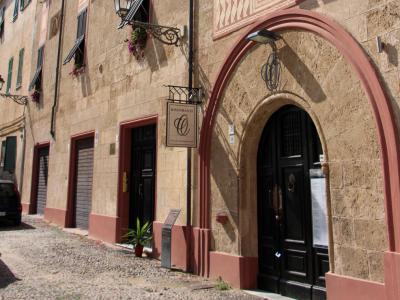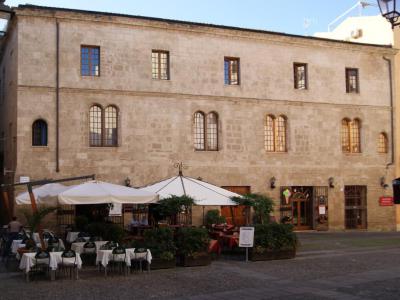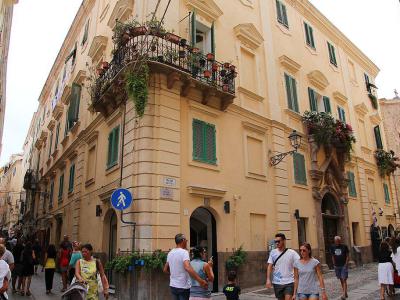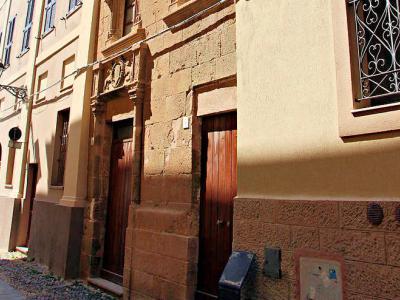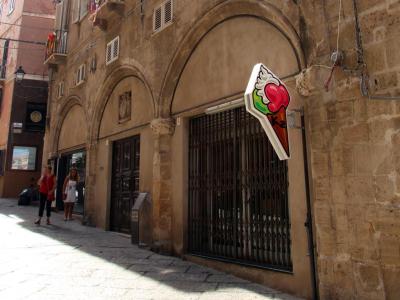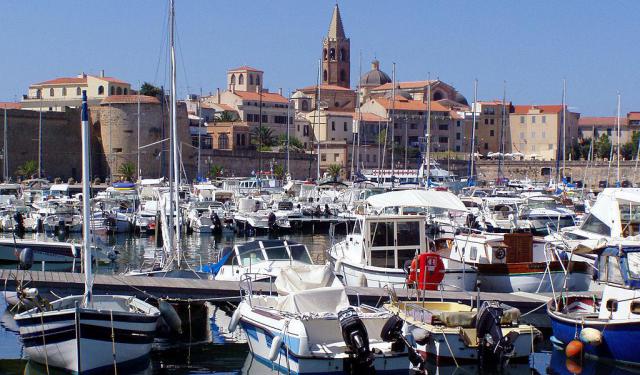
Alghero's Old Palaces (Self Guided), Alghero
Alghero, a historical gem on the northwest coast of Sardinia, is home to some of Italy's most significant architectural monuments. This is evident in the city's remarkable collection of old palaces, showcasing narratives that span centuries.
Carcassona Palace, dating back to the mid-1400s, stands out with its mix of influences from Valencia, Naples, Palermo, and Sardinia. A former residence of royal officials, it carries features emblematic of Aragonese Mediterranean architecture.
Ferrera Palace reflects the opulence and strategic importance of Alghero during the medieval era. With its robust fortifications and sumptuous decorations, this building illustrates the wealth and power of its former residents, a prosperous merchant family.
Serra Palace, another key site, reveals a blend of Gothic-Catalan, Neoclassical, and Baroque styles. Its meticulous restoration allows visitors to appreciate the city’s architectural evolution, making it a significant stop for anyone exploring the historical landscape of Alghero.
The Salty Well Palace combines elements from different periods and carries a unique name that hints at its original function—a communal well, where women prepared bread dough.
Machin and Civic Palaces stand as beacons of civic pride and cultural heritage. While the former used to be the residence of the influential Machin family, the latter, serving as the town hall, has been a center of civic life for centuries, displaying artifacts and documents that narrate the city's history.
Peretti Palace offers an intimate look at Gothic-Catalan architecture, with its grand wooden door and square-shaped sandstone blocks on the main façade facing Roma Street.
Finally, Simon Palace, the last on this historical tour, provides a stark contrast with its symmetrical layout and refined ornamentation, standing as a significant landmark on Gilbert Ferret Street, near the historic San Giovanni Tower.
For those eager to delve into the architectural and historical treasures of Alghero, visiting these palaces offers a profound insight into the city’s past and its cultural transformation. For a history aficionado or anyone keen on the Sardinian heritage, Alghero’s palatial wonders, each with its own story to tell, are definitely not to be missed!
Carcassona Palace, dating back to the mid-1400s, stands out with its mix of influences from Valencia, Naples, Palermo, and Sardinia. A former residence of royal officials, it carries features emblematic of Aragonese Mediterranean architecture.
Ferrera Palace reflects the opulence and strategic importance of Alghero during the medieval era. With its robust fortifications and sumptuous decorations, this building illustrates the wealth and power of its former residents, a prosperous merchant family.
Serra Palace, another key site, reveals a blend of Gothic-Catalan, Neoclassical, and Baroque styles. Its meticulous restoration allows visitors to appreciate the city’s architectural evolution, making it a significant stop for anyone exploring the historical landscape of Alghero.
The Salty Well Palace combines elements from different periods and carries a unique name that hints at its original function—a communal well, where women prepared bread dough.
Machin and Civic Palaces stand as beacons of civic pride and cultural heritage. While the former used to be the residence of the influential Machin family, the latter, serving as the town hall, has been a center of civic life for centuries, displaying artifacts and documents that narrate the city's history.
Peretti Palace offers an intimate look at Gothic-Catalan architecture, with its grand wooden door and square-shaped sandstone blocks on the main façade facing Roma Street.
Finally, Simon Palace, the last on this historical tour, provides a stark contrast with its symmetrical layout and refined ornamentation, standing as a significant landmark on Gilbert Ferret Street, near the historic San Giovanni Tower.
For those eager to delve into the architectural and historical treasures of Alghero, visiting these palaces offers a profound insight into the city’s past and its cultural transformation. For a history aficionado or anyone keen on the Sardinian heritage, Alghero’s palatial wonders, each with its own story to tell, are definitely not to be missed!
How it works: Download the app "GPSmyCity: Walks in 1K+ Cities" from Apple App Store or Google Play Store to your mobile phone or tablet. The app turns your mobile device into a personal tour guide and its built-in GPS navigation functions guide you from one tour stop to next. The app works offline, so no data plan is needed when traveling abroad.
Alghero's Old Palaces Map
Guide Name: Alghero's Old Palaces
Guide Location: Italy » Alghero (See other walking tours in Alghero)
Guide Type: Self-guided Walking Tour (Sightseeing)
# of Attractions: 8
Tour Duration: 1 Hour(s)
Travel Distance: 1.0 Km or 0.6 Miles
Author: Dee
Sight(s) Featured in This Guide:
Guide Location: Italy » Alghero (See other walking tours in Alghero)
Guide Type: Self-guided Walking Tour (Sightseeing)
# of Attractions: 8
Tour Duration: 1 Hour(s)
Travel Distance: 1.0 Km or 0.6 Miles
Author: Dee
Sight(s) Featured in This Guide:
- Palazzo Carcassona (Carcassona Palace)
- Palazzo de Ferrera (Ferrera Palace)
- Palazzo Serra (Serra Palace)
- Palazzo del Pou Salit (Palace of the Salty Well)
- Palazzo Machin (Machin Palace)
- Palazzo Civico (Civic Palace)
- Palazzo Peretti (Peretti Palace)
- Palazzo Simon (Simon Palace)
1) Palazzo Carcassona (Carcassona Palace)
Carcassona Palace, located in the Jewish quarter of Alghero, stands as a significant testament to mid-15th-century architecture and history. This impressive building was a prominent residence for high-ranking officials, including royal prosecutors and governors, who visited or stayed in the city. Notably, the viceroy was once hosted in the residence of Maimone Carcassona, the eldest son of Samuele Carcassona, a prominent Jewish family in Alghero.
The palace's architectural elegance is evident in its sandstone façade, characterized by a distinctive decentralized doorway. This entrance features an adovellado design with a refined molding that frames the arch, echoing architectural motifs found in Valencia, Naples, Palermo, and Sardinia. The lower archway of the building also reflects the Neapolitan style seen in the palaces of Antonello Petrucci and Diomede Carafa, along with influences from various Southern Italian, Barcelona, and Valencia architectural elements.
Above the main entrance, the façade is adorned with four mullioned windows set within a molded rectangular frame, each decorated with a small intertwined trefoil arch. This decorative detail is a hallmark of Aragonese Mediterranean architecture, emphasizing the building's historical and stylistic connections across the region.
Originally featuring a loggia patio and an external staircase leading to the reception hall, Carcassona Palace combined functionality with grandeur. The entrance hall, with its barrel vault, connected the main doorway to the open patio. A distinctive feature of the façade is the ovoid projecting face with wide eyes and a half-open mouth, carved into a block of sandstone. This element is reminiscent of the sculpture on the Maddalena Tower, also known as Garibaldi's Tower, further linking the palace to Alghero's rich architectural heritage.
The palace's architectural elegance is evident in its sandstone façade, characterized by a distinctive decentralized doorway. This entrance features an adovellado design with a refined molding that frames the arch, echoing architectural motifs found in Valencia, Naples, Palermo, and Sardinia. The lower archway of the building also reflects the Neapolitan style seen in the palaces of Antonello Petrucci and Diomede Carafa, along with influences from various Southern Italian, Barcelona, and Valencia architectural elements.
Above the main entrance, the façade is adorned with four mullioned windows set within a molded rectangular frame, each decorated with a small intertwined trefoil arch. This decorative detail is a hallmark of Aragonese Mediterranean architecture, emphasizing the building's historical and stylistic connections across the region.
Originally featuring a loggia patio and an external staircase leading to the reception hall, Carcassona Palace combined functionality with grandeur. The entrance hall, with its barrel vault, connected the main doorway to the open patio. A distinctive feature of the façade is the ovoid projecting face with wide eyes and a half-open mouth, carved into a block of sandstone. This element is reminiscent of the sculpture on the Maddalena Tower, also known as Garibaldi's Tower, further linking the palace to Alghero's rich architectural heritage.
2) Palazzo de Ferrera (Ferrera Palace)
Nestled in the historic heart of Alghero, Ferrera Palace is a splendid example of 15th-century Gothic architecture, built by a prosperous merchant family. Named after Pedro de Ferrera, the palace's facade is characterized by its meticulously arranged square blocks, which are laid horizontally to create a strikingly uniform appearance. The building's robust construction and historical significance make it a notable landmark in the city.
The palace features three floors, each offering a glimpse into its rich past. The grand entrance opens into an impressive foyer, where a majestic staircase ascends through the building. This staircase serves as a focal point of the interior, showcasing the elegance and craftsmanship of the era.
One of the most remarkable features of Ferrera Palace is found on the second floor. Here, four grand arches are carved from a single block of stone, supported by intricately designed columns. These arches not only enhance the aesthetic appeal of the palace but also reflect the advanced stonework techniques of the period.
Historically, Ferrera Palace was a key location during significant events. Notably, it served as the residence of Emperor Charles V during the battle of 1541. The palace's blend of historical grandeur and architectural beauty continues to attract visitors, offering a tangible connection to Alghero's storied past.
The palace features three floors, each offering a glimpse into its rich past. The grand entrance opens into an impressive foyer, where a majestic staircase ascends through the building. This staircase serves as a focal point of the interior, showcasing the elegance and craftsmanship of the era.
One of the most remarkable features of Ferrera Palace is found on the second floor. Here, four grand arches are carved from a single block of stone, supported by intricately designed columns. These arches not only enhance the aesthetic appeal of the palace but also reflect the advanced stonework techniques of the period.
Historically, Ferrera Palace was a key location during significant events. Notably, it served as the residence of Emperor Charles V during the battle of 1541. The palace's blend of historical grandeur and architectural beauty continues to attract visitors, offering a tangible connection to Alghero's storied past.
3) Palazzo Serra (Serra Palace)
Constructed in the late 18th century by one of the city’s affluent landowning families, the Serra Palace stands as a testament to Alghero's rich history and its blend of architectural influences.
The building showcases a fascinating amalgamation of styles, reflecting the diverse architectural heritage of Alghero. Its design incorporates elements of Gothic-Catalan architecture, a style prevalent in the city, alongside Neoclassical and Baroque details. This fusion of styles not only highlights the building's historical context but also contributes to its unique aesthetic appeal.
Despite undergoing restoration over the years, Serra Palace retains much of its original design. The restoration efforts have preserved the integrity of the building, allowing visitors to appreciate its historical charm and architectural complexity. The palace's strategic location at a major intersection further enhances its prominence within Alghero's urban landscape.
Today, Palazzo Serra remains an important landmark, embodying the city's architectural evolution and serving as a striking example of how historical and stylistic influences can coalesce to create enduring beauty.
The building showcases a fascinating amalgamation of styles, reflecting the diverse architectural heritage of Alghero. Its design incorporates elements of Gothic-Catalan architecture, a style prevalent in the city, alongside Neoclassical and Baroque details. This fusion of styles not only highlights the building's historical context but also contributes to its unique aesthetic appeal.
Despite undergoing restoration over the years, Serra Palace retains much of its original design. The restoration efforts have preserved the integrity of the building, allowing visitors to appreciate its historical charm and architectural complexity. The palace's strategic location at a major intersection further enhances its prominence within Alghero's urban landscape.
Today, Palazzo Serra remains an important landmark, embodying the city's architectural evolution and serving as a striking example of how historical and stylistic influences can coalesce to create enduring beauty.
4) Palazzo del Pou Salit (Palace of the Salty Well)
The Palace of the Salty Well derives its name from a local well, known as "Pou" in the local dialect, where women historically gathered to prepare bread dough. This name pays homage to the building's past as a focal point of communal activity. The current structure is a result of combining several architecturally diverse buildings over the years. Originally, it included the residence of the Airaldi Genoese family on one side and part of a church basement from the 1700s on the other, which was annexed to the Cathedral and demolished after World War II.
Architecturally, the Palace of the Salty Well is a blend of styles that reflect its historical layers. Restoration efforts uncovered some Gothic-Catalan elements, particularly on the right side of the façade. Notably, a pointed arch window on the ground floor, now walled up, and a distinctive mullioned window with arches in the middle section showcase Catalan architectural influences. These features are reminiscent of similar designs found in the Hispanic region, such as the episcopal building in Girona.
Today, the palace serves as university offices, continuing to play a role in the community. The building's rich history and architectural complexity make it an important landmark in Alghero's urban landscape. Opposite the Palazzo are the remnants of Casa Manno, the birthplace of Giuseppe Manno, a notable Algherese jurist. Although Casa Manno was demolished in the 1990s, its historical significance remains, particularly its Gothic-Renaissance style evident in the building's decorative elements.
Architecturally, the Palace of the Salty Well is a blend of styles that reflect its historical layers. Restoration efforts uncovered some Gothic-Catalan elements, particularly on the right side of the façade. Notably, a pointed arch window on the ground floor, now walled up, and a distinctive mullioned window with arches in the middle section showcase Catalan architectural influences. These features are reminiscent of similar designs found in the Hispanic region, such as the episcopal building in Girona.
Today, the palace serves as university offices, continuing to play a role in the community. The building's rich history and architectural complexity make it an important landmark in Alghero's urban landscape. Opposite the Palazzo are the remnants of Casa Manno, the birthplace of Giuseppe Manno, a notable Algherese jurist. Although Casa Manno was demolished in the 1990s, its historical significance remains, particularly its Gothic-Renaissance style evident in the building's decorative elements.
5) Palazzo Machin (Machin Palace)
Machin Palace, also known historically as Casa Doria, stands as a testament to the architectural splendor of 16th-century Alghero. Constructed by Bishop Ambrogio Machin for his family, this Gothic-Catalan style building is a notable example of the era's craftsmanship. Built entirely of sandstone ashlars, the palace's façade remains a striking feature, showcasing its Renaissance portal and Gothic-Catalan windows, which reflect the intricate design preferences of its time.
Located in a narrow alley in Alghero's historic center, Machin Palace is characterized by its rich decorations and family coats of arms that adorn its external windows. The façade's ornamentation, including numerous parastras supporting the architrave, adds to its grandeur and historical significance. Despite the heavy damage inflicted during World War II, which left the interior largely in ruins, the façade has been remarkably preserved, offering a glimpse into the building's original architectural elegance.
Today, the palace is under the ownership of the Curia, continuing its legacy as a historical landmark. Its proximity to Municipality Square and its distinctive architectural features make it a significant attraction for visitors exploring Alghero's rich cultural heritage.
Located in a narrow alley in Alghero's historic center, Machin Palace is characterized by its rich decorations and family coats of arms that adorn its external windows. The façade's ornamentation, including numerous parastras supporting the architrave, adds to its grandeur and historical significance. Despite the heavy damage inflicted during World War II, which left the interior largely in ruins, the façade has been remarkably preserved, offering a glimpse into the building's original architectural elegance.
Today, the palace is under the ownership of the Curia, continuing its legacy as a historical landmark. Its proximity to Municipality Square and its distinctive architectural features make it a significant attraction for visitors exploring Alghero's rich cultural heritage.
6) Palazzo Civico (Civic Palace)
The Civic Palace is a distinguished example of 19th-century Neoclassical architecture. Constructed during a period of significant urban development, the building's façade is composed of squared sandstone blocks set upon a granite base. This solid foundation contributes to its stately appearance, while the elegantly framed wooden front door, accented by smaller sandstone blocks, provides a welcoming entry point to the grand structure.
The interior of Civic Palace is equally impressive, with a ceiling adorned by intricate frescoes that add to the building's historic charm. These decorative elements reflect the artistic sensibilities of the time and contribute to the overall grandeur of the space. The hall's decor has been carefully preserved, maintaining the building's aesthetic continuity from its original design.
Today, Civic Palace serves as Alghero's Town Hall, a central hub for local administration and community events. Its location near Diva Caffe' Di Peana Giovanni positions it prominently within the bustling Municipality Square, making it a focal point for both residents and visitors. The palace is also a popular venue for weddings, providing a picturesque setting for special ceremonies and celebrations.
The Civic Palace's Neoclassical façade and historic interior make it a notable landmark in Alghero, reflecting the city's rich architectural heritage and its continued role as a center of civic life. Its blend of historical significance and functional use underscores its importance in the cultural and administrative landscape of the city.
The interior of Civic Palace is equally impressive, with a ceiling adorned by intricate frescoes that add to the building's historic charm. These decorative elements reflect the artistic sensibilities of the time and contribute to the overall grandeur of the space. The hall's decor has been carefully preserved, maintaining the building's aesthetic continuity from its original design.
Today, Civic Palace serves as Alghero's Town Hall, a central hub for local administration and community events. Its location near Diva Caffe' Di Peana Giovanni positions it prominently within the bustling Municipality Square, making it a focal point for both residents and visitors. The palace is also a popular venue for weddings, providing a picturesque setting for special ceremonies and celebrations.
The Civic Palace's Neoclassical façade and historic interior make it a notable landmark in Alghero, reflecting the city's rich architectural heritage and its continued role as a center of civic life. Its blend of historical significance and functional use underscores its importance in the cultural and administrative landscape of the city.
7) Palazzo Peretti (Peretti Palace)
The Peretti Palace stands as a testament to the city’s rich historical and architectural heritage. Constructed in the 15th century by the noble Guyo Duran family, the palace is an exemplary example of Gothic-Catalan style. Its historical significance is underscored by its continued ownership by the Peretti family, who acquired the building in the 18th century after it was purchased from the original owners.
The façade of Peretti Palace is particularly striking, featuring a grand wooden door that serves as a focal point for the building’s exterior. This door is flanked by intricately designed stone elements that highlight the craftsmanship of the period. The main façade, facing Roma Street, is composed of square-shaped sandstone blocks, which contrast with the plastered surfaces of the other parts of the building. This combination of materials provides a distinctive character and historical depth to the palace.
Despite its age, the Peretti Palace has maintained its architectural integrity, with the main facade remaining a prominent feature of the city’s landscape. The building’s Gothic-Catalan elements are evident in the decorative details and the overall layout, reflecting the style and sensibilities of the era in which it was built.
The façade of Peretti Palace is particularly striking, featuring a grand wooden door that serves as a focal point for the building’s exterior. This door is flanked by intricately designed stone elements that highlight the craftsmanship of the period. The main façade, facing Roma Street, is composed of square-shaped sandstone blocks, which contrast with the plastered surfaces of the other parts of the building. This combination of materials provides a distinctive character and historical depth to the palace.
Despite its age, the Peretti Palace has maintained its architectural integrity, with the main facade remaining a prominent feature of the city’s landscape. The building’s Gothic-Catalan elements are evident in the decorative details and the overall layout, reflecting the style and sensibilities of the era in which it was built.
8) Palazzo Simon (Simon Palace)
Simon Palace stands prominently on Gilbert Ferret Street in Alghero, near the historic San Giovanni Tower. Originally constructed in the late 13th century, this elegant building has undergone significant restoration, particularly in the late 19th century. Its architectural design reflects the Neoclassical style, characterized by clean lines, grand proportions, and classical detailing.
The façade of Simon Palace is distinguished by a massive front door framed by a gracefully arching entrance. Above this door, the emblem of the Simon family, the palace's original owners, is prominently displayed. This emblem adds a touch of historical significance and personal connection to the building's past.
The Neoclassical design of Simon Palace is evident in its symmetrical layout and refined ornamentation, which are hallmarks of the style. The building's restoration has preserved these elements, ensuring that the palace remains a striking example of architectural elegance.
Today, Simon Palace is a notable feature of Alghero's historic streetscape, offering a glimpse into the city's rich architectural and familial heritage. Its prominent location and historical significance make it an important landmark for both visitors and locals alike.
The façade of Simon Palace is distinguished by a massive front door framed by a gracefully arching entrance. Above this door, the emblem of the Simon family, the palace's original owners, is prominently displayed. This emblem adds a touch of historical significance and personal connection to the building's past.
The Neoclassical design of Simon Palace is evident in its symmetrical layout and refined ornamentation, which are hallmarks of the style. The building's restoration has preserved these elements, ensuring that the palace remains a striking example of architectural elegance.
Today, Simon Palace is a notable feature of Alghero's historic streetscape, offering a glimpse into the city's rich architectural and familial heritage. Its prominent location and historical significance make it an important landmark for both visitors and locals alike.
Walking Tours in Alghero, Italy
Create Your Own Walk in Alghero
Creating your own self-guided walk in Alghero is easy and fun. Choose the city attractions that you want to see and a walk route map will be created just for you. You can even set your hotel as the start point of the walk.
Alghero Introduction Walking Tour
Alghero, a charming coastal town in Sardinia, Italy, is a unique historical place where the Sardinian and Catalan cultures united.
The area’s history stretches back way before Christian times. The Phoenicians arrived here in the 8th century BC, establishing a metalworking settlement called Saint Imbenia.
Later, this strategic Mediterranean location attracted the Genoese Doria family, who... view more
Tour Duration: 2 Hour(s)
Travel Distance: 1.6 Km or 1 Miles
The area’s history stretches back way before Christian times. The Phoenicians arrived here in the 8th century BC, establishing a metalworking settlement called Saint Imbenia.
Later, this strategic Mediterranean location attracted the Genoese Doria family, who... view more
Tour Duration: 2 Hour(s)
Travel Distance: 1.6 Km or 1 Miles
The Most Popular Cities
/ view all
